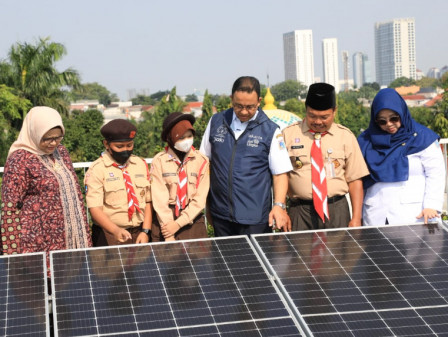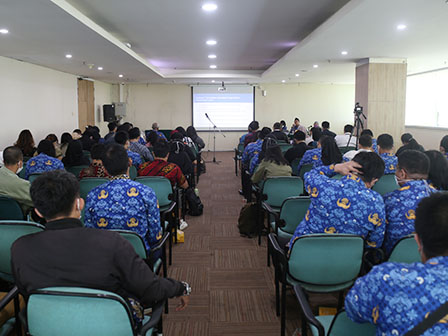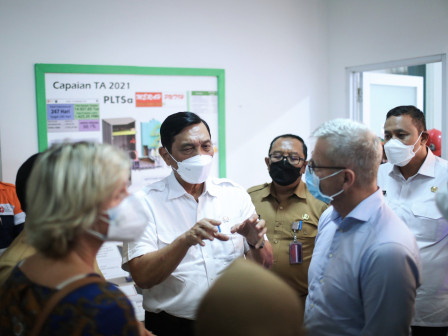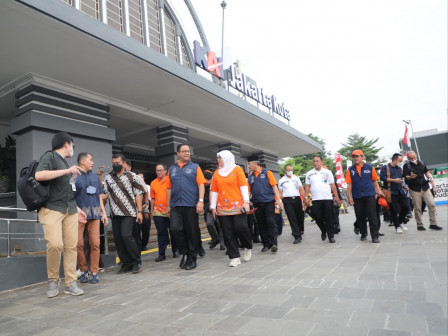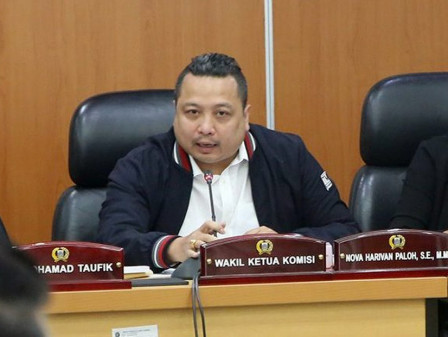Commitment to Zero Carbon Emissions, City Inaugurates Four Schools with Green Building Concept
Reported by TP Moan Simanjuntak | Translated by Nugroho Adibrata
The Jakarta administration is committed to supporting various steps in realizing low-emission activities in every corner of the city in a bid to maintain Jakarta's sustainability.
We want school buildings to inspire and stimulate people to think and imagine
That is starting from an integrated transportation system, building transit-oriented infrastructure, implementing a low emission area in the Old City, testing emissions for private vehicles, to using the green building concept in the construction of a building.
It is also realized through the inauguration of four net zero carbon schools and green buildings as a pilot project, namely SDN Duren Sawit 14 (East Jakarta); SDN Grogol Selatan 09 (South Jakarta); SDN Ragunan 08 Pagi, 09 Pagi, 11 Petang (South Jakarta); and SMAN 96 Jakarta (West Jakarta).
Jakarta Opens Collaboration for Implementation of Air Pollution Control StrategiesThe building with the Net Zero Carbon concept is an energy-efficient building when operating and most of its energy needs are supplied from renewable energy sources. Thus, the resulting carbon emissions are very minimal.
Jakarta Governor Anies Baswedan inaugurated the Net Zero Carbon School and at the same time handed over the Greenship Net Zero Healthy Certificate from the Green Building Council (GBC) Indonesia to the four schools at SDN Ragunan 08, South Jakarta on Thursday (9/29).
"Today, we're witnessing a historic event that today in Jakarta we are officially the first public school to carry the concept of green building and net zero emissions," he expressed, as quoted by Jakarta PPID's press release.
In his speech, he stated that school buildings are the most owned buildings by the government. While, speaking of global carbon emissions, buildings contribute 39% of global carbon emissions, and consume 36% of total global energy.
“So, the building is the biggest contributor. We often see decarbonization that is seen as just a motor vehicle, but no, actually the building consumes 36 percent of energy and contributes 39 percent to global carbon emissions," he explained.
“If we don't correct the buildings, especially in urban areas, the air quality in this place will always face problems. Therefore, why do we have to go to green building and we start from our schools," he continued.
He emphasized that a building labeled as a school is a place for interaction between students, educators, and parents. If the school building is designed properly, it will make the learning process run much better and more enjoyable.
He hoped that the school building with the green building concept could be a direct educational medium for children, where they will have an idea of how environmentally friendly buildings are, so it will be by the spirit of Jakarta to become a global city whose people care about various global issues.
“We want school buildings to inspire and stimulate people to think and imagine. They will learn from this building, such as electrical engineering, then solar panels, where there is pure physics, there is applied physics. So, the material in this building suddenly became a teaching tool for teachers," he explained.
"Jakarta must be on par with other global cities in the world and that means our schools must be able to educate children to compete with the results of school education in other global cities," he added.
In the future, the overall rehabilitation of public school buildings in Jakarta will lead to the concept of green building, starting from the transition of energy with solar panels, the use of energy-saving lamps, to wastewater management.
"Hope the construction of the Net Zero Carbon School can also trigger Jakarta to achieve the target of net zero emissions or zero carbon emissions by 2050. We are trying to make this city a sustainable city in the future," he added.
As for the information, the administration is collaborating with GBC Indonesia in implementing this Net Zero Carbon School. GBC Indonesia helps perform simulations and analyses related to passive designs, especially simulations for airflow patterns on the site, solar radiation on the building envelope, as well as lighting simulations to determine whether the building's performance is good and can reduce energy use.
Airflow simulation can help predict general wind direction and speed thus designers can position openings to maximize natural ventilation.
Simulation of solar radiation on the building envelope helps to identify the building envelope that is exposed to the sun's heat which can affect the indoor temperature thus the use of air conditioning can be minimized.
Moreover, natural lighting is very important in schools as it affects children's learning performance. To increase the efficiency of energy use in lighting or lamps, natural sunlight must be utilized while taking into account the thermal comfort in the space.
Principally, the requirements and conditions of buildings with Net Zero Carbon criteria are to optimize the design of the building in such a way that it can reduce the need for energy consumption per year (IKE = Energy Consumption Index) as low as possible, thus enabling its energy supply to rely entirely on renewable energy systems.
The renewable energy system is expected to meet the needs of building energy consumption (IKE) which has been greatly minimized compared to the IKE required by conventional building practices.
Besides the urgency to go to low-emission buildings, the need to go to healthy buildings amid the Covid-19 pandemic is a must.
It is because based on survey results, humans tend to spend more than 90% of their time indoors. Thus, it needs to pay attention to how the air quality in the room, where the occupants carry out activities.
Prevention and mitigation efforts need to be optimized and can be observed from a flashback of the process of spreading Covid-19 so far. Based on the cases that have occurred, health protocols are very important as a form of control over the source of the spread of the virus but only regulate human activities and minimize interactions between humans.
The emergence of indoor pandemic clusters confirms the need for prevention efforts other than health protocols, namely changes in buildings and the environment where humans move to become safe and healthy places.
